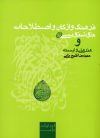
Manuscripts in the news
The study of Islamic manuscripts is a dynamic field of research. This section in the Islamic manuscripts site gives a follow-up to stories in the news and signalizes new publications and events. Readers are invited to offer their notes and remarks (and if possible images as well) for short news flashes. Announcements of new books and new issues of scholarly journals are equally welcome. For further information, please contact the editor.
September 21, 2009: A new dictionary of terminology in connection with Islamic manuscripts.
Just published: Hamid Reza Ghelichkhani, Farhang-i Wazhegan wa Istilahat-i Khushnawisi wa Hunar-hayi Wabasteh. Tehran, 2nd edition (Intisharat-i Ruzana) 1388/2009, 464 pp., price 6950 toman (22 cm, ISBN 978-964-334-013-1. Text in Persian, illustrated). English title: A Dictionary of Calligraphy and Related Arts. See cover and introduction(here).
The first edition of this dictionary of terminology used in calligraphy and related arts appeared in Tehran in 1994. The second, greatly enlarged and completely rewritten, edition appeared in 2008. The edition which we have under review here seems to be a reimpression made in 2009. The author, Hamid Reza Ghelichkhani (born 1347/1968-1969), is head of the Calligraphy Departement in The Iranian Academy of the Arts in Tehran. Presently he is working, together with a group of calligraphy masters, on a series of biographies and studies on the works of great calligraphers, meant to be an elaboration and expansion of this work on terminology. The present dictionary is not the first work of its kind, nor will it be the last one. In the study of Islamic book arts Ghelichkhani's dictionary is certainly a landmark and its publication deserves more than casual attention.
The dictionary is an integral work containing classical, traditional and modern terminology, the latter often of Western origin. This makes sense because calligraphy, and the other arts of the book for that matter, are enthoustically practiced in Iran nowadays where they enjoy a wide popularity, even more so - it would seem - than in the neighbouring countries of the Middle East. This does not only go for the modern practice of calligraphy in the educated layers of Iranian society, but also for the impressive heritage of Persian calligraphy. Calligraphy and book art have always been an outstanding Persian speciality, both within the political boundaries of present-day Iran and beyond, and Mr. Ghelichkhani's dictionary proves this once more. I am not aware of any other Islamic country where calligraphy plays such an important and all-pervasive role as in Iran, even to the extent that the two major writing styles, nasta`liq and the more difficult shikasteh, have come to be directly associated with Iranian culture. Writing well and beautifully is taught from early school years onwards, and in that sense Iran too can be called a calligraphic state (though in a somewhat different sense from Brinckley Messick's book of 1993 on the Yemen which goes by that title).
So, far from describing a historical phenomenon, Ghelichkhani describes an old craft that is still vibrantly alive in present-day Iran. A look around in the bookshops opposite Tehran University will easily convince the scepticist. Shelvings full of books on calligraphic styles and techniques, supplemented by a generous supply of reed pens, inks, drawing papers and pen cases of all kinds, just prove the point. Knowing the terminology is knowing the field in which that terminology is used, and Ghelichkhani's dictionary is so attractively written and illustrated that it invites reading, not just looking for references. The dictionary's use is further enhanced by the inclusion of Persian-English and English-Persian glossaries. In all, some one-thousand terms and concepts are treated, sometimes with succinct, very matter-of-fact explanations, but sometimes with descriptions that verge on the encyclopaedic. The book is well-illustrated, in black-and-white, the illustrations showing not only images from both Iranian and foreign manuscript collections, but also objects and instruments which are important to calligraphy and the art of the Islamic book
http://www.islamicmanuscripts.info/news/index.html